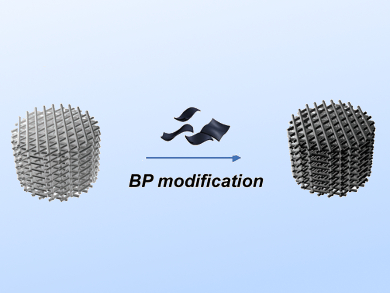Osteosarcoma is a type of bone cancer. Treating this disease involves both killing the cancer cells and regenerating bone to fill the resulting defects. One approach to destroying cancer cells is the use of photothermal therapy. This involves shining light on a photosensitizer material, such as black phosphorus (BP) nanosheets, which produces heat that kills the cells. 3D-printed artificial scaffolds can then be used to steer bone regeneration.
Yu Chen and Jianlin Shi, Shanghai Institute of Ceramics, Chinese Academy of Sciences, Youshui Gao, Shanghai Jiao Tong University, China, and colleagues have combined a photothermal therapy agent and a 3D-printed scaffold for a bifunctional osteosarcoma treatment. The team designed and printed scaffolds from bioglass, a glass with high calcium and phosphate content. Then the scaffolds were soaked in a solution of BP nanosheets to modify their surface and give the finished hybrid material (pictured right).
The BP nanosheets have a high photothermal conversion efficiency, which makes them suitable for treating tumors. The temperature of the scaffold was increased from 32.4 to 68.7 °C under 808 nm laser irradiation in five minutes. In addition, the nanosheets release phosphate when oxidized, which promotes the formation of new bone. According to the researchers, the hybrid scaffold could provide an efficient localized treatment of osteosarcoma.
- 2D-Black-Phosphorus-Reinforced 3D-Printed Scaffolds: A Stepwise Countermeasure for Osteosarcoma,
Bowen Yang, Junhui Yin, Yu Chen, Shanshan Pan, Heliang Yao, Youshui Gao, Jianlin Shi,
Adv. Mater. 2018.
https://doi.org/10.1002/adma.201705611



